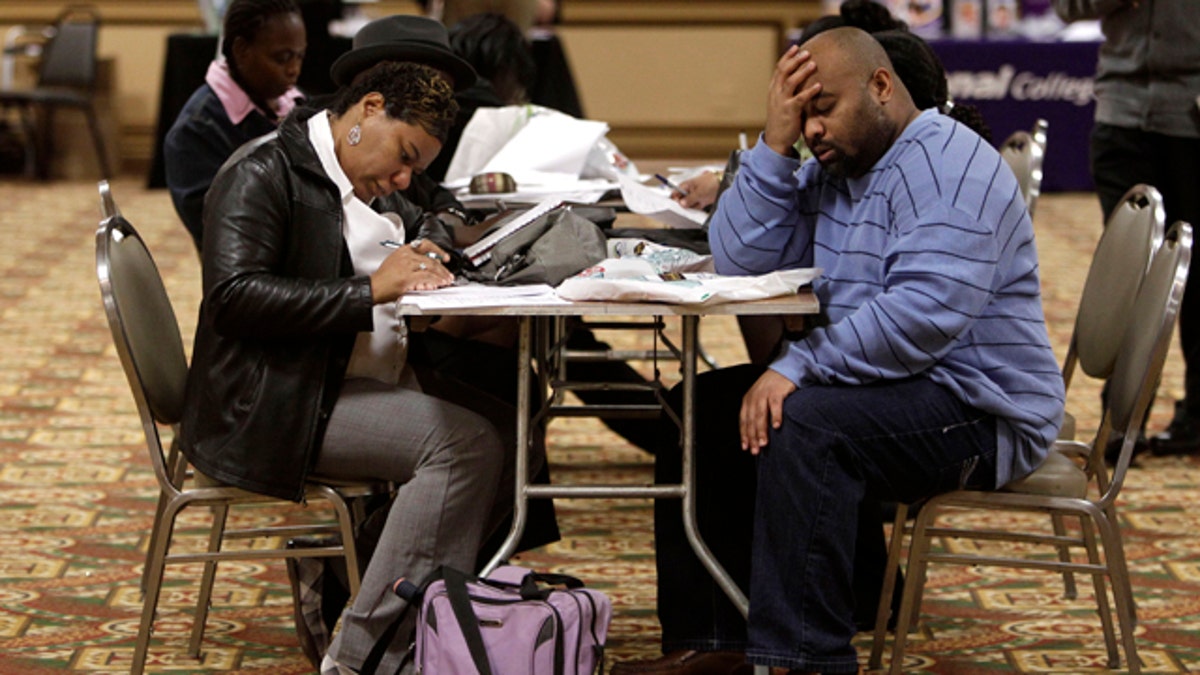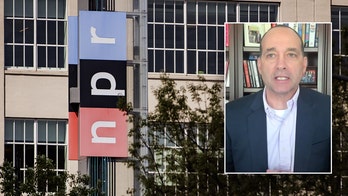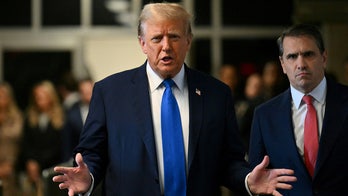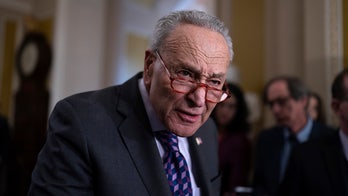
Oct. 26, 2011: Tonya Crenshaw and Kendrick Haraalson fill out applications at a job fair in Brookpark, Ohio. The number of people seeking unemployment benefits dipped slightly last week, though not by enough to suggest that hiring is picking up. (AP)
Jobless numbers remained at a perilously high 402,000 last week, the Labor Department reported Thursday, even as the U.S. economy overall showed modest growth in the third quarter, offering a hopeful glimmer that the jobless rate could improve in the coming months.
The Commerce Department reports that the economy expanded at an annual rate of 2.5 percent in the July-September quarter, buoyed by stronger consumer spending on cars, clothing, health care and utilities, as well as greater business investment.
That's nearly double the 1.3 percent growth in the second quarter spanning April-June and an anemic 0.9 percent growth for the entire first half of the year. Analysts project similar growth for the October-December quarter as the most recent numbers.
While 2.5 percent growth is enough to ease recession fears, it's far below what's needed to lower painfully high unemployment. That 402,000 number dropped slightly from the previous week, but is still higher than the 400,000 that analysts had been expecting.
Benefit applications have stuck above 400,000 for all but two weeks since March. Analysts say they need to drop below 375,000 on a consistent basis for the unemployment rate to see notable improvements.
The number of laid-off workers receiving benefits dropped to 3.65 million, the lowest level in three years.
The White House breathed a sigh of relief but still pushed for Congress to pass President Obama's $447 billion jobs bill that has been broken up into pieces after the Senate rejected the whole package.
"While the continued expansion is encouraging, faster growth clearly is needed to replace the jobs lost in the recent downturn and to reduce long-term unemployment," Katharine Abraham, a member of the White House Council of Economic Advisers, wrote on the White House blog.
"We are, nonetheless, at a fragile moment in the world economy, and cannot afford to do anything to undermine our economic recovery," she wrote. "That's why the president continues to urge Congress to pass the American Jobs Act without delay."
Economists believe that growth in consumer spending, which accounts for about 70 percent of economic activity, will be restrained until incomes start growing at healthier levels. That is unlikely until hiring picks up.
Paul Ashworth, chief U.S. economist for Capital Economics, predicts that growth will cool off in the fourth quarter and next year.
Nonetheless, the report on U.S. gross domestic product, or GDP, sketched a more optimistic picture for an economy that only two months ago seemed destined for another recession.
And it was delivered on the same day that European leaders announced a deal in which banks would take 50 percent losses on Greek debt and raise new capital to protect against defaults on sovereign debt.
Stocks surged on the European deal and maintained their gains after the report on U.S. growth was released.
"This has been a morning of encouraging news," said Jennifer Lee, a senior economist for BMO Capital Markets. "The fourth quarter may see some pullback in U.S. economic growth ... but the positive details underlying the GDP report should help ease fears of a U.S. recession..somewhat."
Consumers helped drive much of the growth. They spent at an annual rate of 2.4 percent. Many bought more furniture and clothing.
And spending on services rose 3 percent, the most in more than five years. Much of the gain was due to consumers paying more for health care and to cool their homes during an unseasonably hot summer.
Still, after-tax incomes adjusted for inflation fell at a rate of 1.7 percent in the summer. It was the biggest decline since the third quarter of 2009 -- just as the recession was ending.
Businesses also helped boost third-quarter growth by stepping up their investment in equipment and software. That category surged 17.4 percent -- nearly three times the rate from spring. They also invested more in building, a sign that some businesses could be expanding despite the sluggish economy.
The GDP report measures the country's total output of goods and services. It covers everything from bicycles to battleships, as well as services such as haircuts and doctor's visits.
In August, many feared the economy was destined for another recession after the government said growth fell to less than 1 percent for the first six months of the year.
High gas prices, the growing debt crisis in Europe and wild fluctuations in the stock market also contributed to those fears, which have receded in recent weeks after reports showed improvements in hiring and consumer spending.
Economists project an annual growth rate of 2.5 percent to 3 percent for the October-December quarter and for all of next year -- just enough to keep the unemployment rate from rising.
For the 14 million people who are out of work and want jobs, that's discouraging news. And it's an ominous sign for President Obama, who will be facing voters next fall.
There have been some encouraging signs.
A measure of business investment plans rose in September for the second straight month and by the most in six months, according to a government report Wednesday on orders for longer-lasting manufactured goods.
And consumers stepped up their spending on retail goods in both July and September. The main reason for the September gain was more people bought new cars, a purchase people typically make when they are confident in their finances.
Economists warned that even their modest assessment of growth of around 2.7 percent for next year will fall short if the European debt crisis isn't resolved. And the outlook could dim further if U.S. lawmakers allow a Social Security tax cut and extended unemployment benefits to expire at the end of this year.
The Associated Press contributed to this report.




